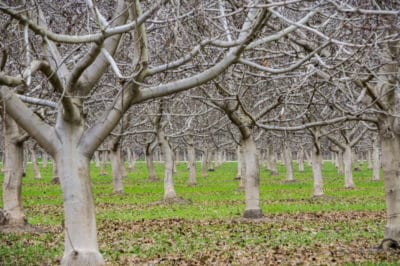Pruning at Planting
This is the easiest pecan tree pruning you’ll ever do, because the trees are small and the strategy simple. Using clean, sharp pruning shears, remove the one-third to one-half of the tree. This should leave you with a trunk, or whip, from 3 to 3 1/2 feet tall.
While this pruning sounds extreme, two or three vigorous shoots will emerge just below the pruning cut the following spring. One of them will eventually become the tree’s central leader.
Dormant Season Pruning of Young Pecan Trees
For their first four or five years after planting, prune during winter dormancy. Most pecan trees growing in USDA plant hardiness zones 6 through 9 are dormant between late November and February.
- In the first year, cut the most vigorous shoot at the top of a tree back by one-third to one-half. Remove the rest of the strong top shoots. Tip prune all side branches and shoots measuring 1 to 1 ½ feet long by pinching their growing tips back 2 inches.
- In the second year, cut back one-third to one-half of the most vigorous, straightest top shoot to confirm it as the leader. Remove the second-strongest shoot completely. Tip prune side shoots measuring 12 to 32 inches long.
- During the third and fourth years, remove all side branches measuring 1 or more inches around and less than 4 feet from the ground. Tip prune the remaining side branches and shoots.
Pruning for Strong Scaffold Limbs
In the trees’ fourth-year dormancy, prune to create strong scaffold limbs for the canopies. Remove side branches lower than 5 feet from the ground or that form less than 45-degree angles with the leader.
Then begin removing the remaining side branches in a spiral, until you have between six and 10 spaced 8 to 14 inches apart around the leader.
Pruning Mature Pecan Trees
Go easy on pruning mature pecans, or they may stop producing for several years. Stick to corrective pruning during dormancy to remove:
- Crossed, broken, diseased or dead branches.
- Branches and shoots blocking air and light in the center of the canopies.
- New branches growing at less than 45-degree angles.
- Low branches that interfere with watering or harvesting.
Expert gardener’s tips: To protect your trees against fungal or bacterial infections, always seal your pruning cuts with a coat of white latex paint.
